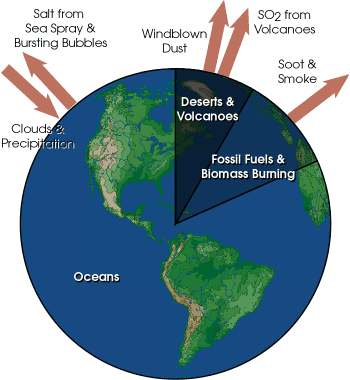Atmospheric Aerosols
Aerosols are tiny particles that are capable of suspending in the atmosphere. Most come from natural means such as dust storms, volcanoes, fires, or even vegetation and sea spray (sea salt released into the atmosphere). Human activity also contributes aerosol pollution through the alteration of natural surface cover, industrial pollutants, and the burning of fossil fuels.
There are natural aerosols and aerosol pollutants. Combined, the total amount, and type, of aerosols affect the amount of atmospheric forcing imposed inside the climate system. This is because some aerosols help reflect sunlight back out into space. This reduces the amount of solar energy reaching the earth’s surface. To calculate total warming and cooling potentials, the total effect of aerosols and greenhouse gases (GHG’s) needs to be calculated.
Atmospheric aerosol pollution, mixed with natural aerosols in the context of human caused global warming presents some interesting and extremely important challenges for consideration. Industrial aerosol pollution is contributing to negative climate forcing. That means that if the pollution becomes too detrimental to human health and we stop that pollution, we will warm even faster.
Accurate atmospheric measurement of human-emitted greenhouse gases, such as carbon dioxide, methane, nitrous oxide, and the chlorofluorocarbons, have been made for decades. These greenhouse gases tend to build up fairly uniformly in the atmosphere, so the global buildup is straightforward to measure and well documented.
It is more challenging to measure the impact of aerosols, because they rain or settle out of the atmosphere within a few days, so don’t build up uniformly. Aerosols of human origin are often concentrated downwind of urban centers. Still, it’s clear from the available evidence that humans have caused an increase in aerosols globally. Overall, the evidence suggests that the aerosol buildup is causing a net cooling both because aerosols reflect incoming sunlight back to space (a direct effect) and because they “seed” cloud droplets, causing clouds to become brighter and more reflective (an indirect effect).
Current: The net current effect, within the error bars, calculated on the mean (average center) the formula looks like this. From thermal equilibrium (radiative forcing relatively zero including natural variation) for the past 10,000 years (Holocene), since the beginning of the Industrial age, the earth climate system is currently estimated to be 3.6 W/m2 positively charged (GHG’s, and -2.0 W/m2 negatively charged (aerosols). Thus the total system is estimated to me 1.6 W/m2 positively charged.
The warming that would have occurred from the greenhouse gas buildup has therefore been substantially offset by a cooling from aerosols. But mainly because of uncertainty in the aerosol effect, the overall net forcing is quite uncertain, but still indicated to be positive. Looking further into the future, the effect of greenhouse gases will almost certainly eventually overwhelm the aerosol effect because the greenhouse gases have lifetimes of decades to millennia, while aerosols have lifetimes of days to weeks. Even with steady emissions, the greenhouse gases will continue to buildup in the atmosphere, while the aerosol amounts would stay unchanged.
There are also strong reasons to reduce aerosol pollution, which is associated with health problems and reduced atmospheric visibility. Sulfate aerosols from coal burning lead to acid rain. Reducing aerosol pollution may unleash additional warming, however, so it’s a very complex issue.
Links
- https://earthobservatory.nasa.gov/Features/Aerosols/
- https://earthobservatory.nasa.gov/Features/SmokeClouds/
- https://earthobservatory.nasa.gov/Features/DustBowl/
- https://earthobservatory.nasa.gov/Features/Volcano/
RealClimate Aerosols:
- Yet more aerosols: Comment on Shindell and Faluvegi
- Aerosol formation and climate, Part I
- Aerosol effects and climate, Part II: the role of nucleation and cosmic rays.
- Global Dimming? (
 ) (
) ( )
) - Global Dimming II (
 ) (
) ( )
) - Pollution-Climate Connections (
 ) (
) ( )
) - Global Dimming may have a brighter future (
 ) (
) ( )
) - Climate sensitivity and aerosol forcings
- An Aerosol Tour de Forcing
- Global Dimming and climate models
- Current volcanic activity and climate?
- Aerosols: The Last Frontier? (
 ) (
) ( )
) - Ozone impacts on climate change
- Perspectives from China
- Global dimming and global warming
- Aerosols, Chemistry and Climate

